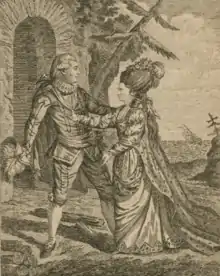George Mattocks
George Mattocks (1735–1804) was a British stage actor and singer.

He appeared at Southwark Fair in 1747 as a child performer and the following year appeared at Bartholomew Fair.[1] Originally billed as George Maddox when he started at Drury Lane he soon altered the spelling of his name and was a regular member of the company from 1749 to 1752, also appearing at Richmond Theatre.[2]
He was absent from the London stage for several years, appearing at Bristol's Jacobs Well Theatre before returning to join the Covent Garden company in 1757. He remained at the theatre for the next twenty five years, particularly appearing in ballad operas and other musical events, some straight comedy but almost never tragedies.[3] In 1762 he was featured in Thomas Arne's opera Artaxerxes.[4] By 1760, he also became the lieutenant of Madame Capte Deville, the manager of Plymouth's summer company.[5] A year later, he bought half of Plymouth's Franfkford Gate Theatre and managed it until 1763.[5] This was where he hired John and Ann Barrington as well the actress Isabella Hallam, who grew up with their family.[5]
In 1765, he married actress Hallam, who was afterwards billed Isabella Mattocks.[5] Because he had previously had two children with the actress Harriet Pitt, her Isabella's guardians were opposed to the marriage so they eloped to France.[6] Mattocks had his first acting appearance in Liverpool at the Drury Lane Theatre in 1767.[7]
One of his final parts at Covent Garden was in John O'Keeffe's The Castle of Andalusia in 1782.[6] He had continued to tour Britain in the summer, and was particularly associated with Liverpool and later Edinburgh, where he was stage director during his final years. Around 1784, he was identified as a co-partner of Joseph Younger in the management of the Theatre Royal Liverpool.[8]
Mattocks died in 1804 and was buried in Edinburgh.[6]
References
- Highfill, Burnim & Langhans p.142
- Highfill, Burnim & Langhans p.142-43
- Highfill, Burnim & Langhans p.143
- Gilman p.340
- Johnson, Odai (2017). London in a Box: Englishness and Theatre in Revolutionary America. Iowa City: University of Iowa Press. p. 86. ISBN 978-1-60938-494-4.
- Highfill, Burnim & Langhans p.146
- Broadbent, R. J. (1908). Annals of the Liverpool Stage: From the Earliest Period to the Present Time, Together with Some Account of the Theatres and Music Halls in Bootle and Birkenhead. Liverpool: E. Howell. pp. 53–54.
- Cerberus (1812). Theatrical Inquisitor, Volume I. London: Sherwood, Neely and Jones. p. 100.
Bibliography
- Gilman, Todd. The Theatre Career of Thomas Arne. Rowman & Littlefield, 2013.
- Highfill, Philip H, Burnim, Kalman A. & Langhans, Edward A. A Biographical Dictionary of Actors, Actresses, Musicians, Dancers, Managers, and Other Stage Personnel in London, 1660–1800: Volume 4. SIU Press, 1975.